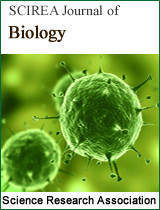Contribution to the Calopteryx-forms of the Peloponnesus (Odonata: Calopterygidae)
DOI: 10.54647/biology180295 74 Downloads 51500 Views
Author(s)
Abstract
Forty-four specimens of the Calopteryx splendens/ balcanica complex of the Peloponnesus and adjacent areas have been found and were analyzed by different methods. The aim of this study is to characterize a Calopteryx form with broad wings found 1979 in the Peloponnesus. The length and width of the fore wings of all found specimens were measured. A resulting quotient was used in our analysis. This analysis recovered two principal groups of Calopteryx, one mainly from the Southern Peloponnesus and one with specimens of Calopteryx balcanica from other locations in Greece and other Calopteryx species from other countries North, West and East of Greece. Some other structures of the wings have also been analyzed. Calopteryx specimens from Southern Peloponnesus have broad fore wings; and in some areas of the wings typical structures may be observed. The status of the Calopteryx form from the Southern Peloponnesus is discussed. The results lead to the conclusion, that the specimens from the South of the Peloponnesus may be an atavistic population of C. balcanica resulting from glacial periods. The Northern forms of C. balcanica may be influenced by other forms of Calopteryx. The Northern form was named C. balcanica by Fudakowski (1930) from Bosnia and Herzegowina. The status of this Calopteryx form of the Southern Peloponnesus should be further investigated.
Keywords
Calopteryx splendens/ balcanica, Southern Peloponnesus, Greece, River Eurotas, cluster analysis, wing size
Cite this paper
Matthias Hartung,
Contribution to the Calopteryx-forms of the Peloponnesus (Odonata: Calopterygidae)
, SCIREA Journal of Biology.
Volume 8, Issue 4, August 2023 | PP. 99-117.
10.54647/biology180295
References
| [ 1 ] | Adomovic Z.R. & S.T. Vijatov (1996): Morphometric examination of Calopteryx balcanica Fudakowski, 1930 and C. splendens ancilla Selys, 1853 (Zygoptera: Calopterygidae). Odonatologica 25: 109-118 |
| [ 2 ] | Dumont H. J. (2006): Calopteryx Leach, 1814. Demoiselles. In: Dijkstra K.-D.B. & R. Lewington (Eds), Field guide to the dragonflies of Britain and Europe: 66-67. British Wildlife Publishing, Gillingham: 320 S. |
| [ 3 ] | Fudakowsky J. (1930): Über die Formen von Calopteryx splendens Harr. aus Dalmatien and Herzegowina (Odonata). Annales Musei Zoologici Polonici IX (6): 57-63, pl. X |
| [ 4 ] | Galletti, P. A. & M. Pavesi (1983): Su alcuni Odonati di Grecia. G. it. Ent. 1: 247-260 |
| [ 5 ] | Geijskes, D. C. & J. van Tol (1983): De libellen van Nederland. Koninklijke Nederlandse Natuurhistorische Verenigung. Hoogwoud (N.H.): 368 S. |
| [ 6 ] | Lohmann H. (1992): SIO/IUCN-Expedition nach Süditalien und Griechenland 17.6-6.7.1992. Unveröffentlichtes Manuskript, Rheinfelden |
| [ 7 ] | Lopau W. (2010): Verbreitungsatlas der Libellen in Griechenland (Odonata). Libellula Supplement 10: 5-153. |
| [ 8 ] | Sadeghi S., T. Kyndt & H. J. Dumont (2010): Genetic diversity, population structure and taxonomy of Calopteryx splendens (Odonata: Calopterygidae): An AFLP analysis. Eur. J. Entomol. 107: 137–146 |
| [ 9 ] | Sadeghi S., D. Adriaens & H. J. Dumont (2009): Geometric morphometric analysis of wing shape variation in ten European populations of Calopteryx splendens (Harris, 1782) (Zygoptera: Calopterygidae). Odonatologica 38(4): 341-357 |
| [ 10 ] | Sadeghi S. & H. J. Dumont (2014): Variation in the shape of the wings and taxonomy of Eurasian populations of the Calopteryx splendens complex (Odonata: Calopterygidae). Odonatologica 111: 575–583. |
| [ 11 ] | Schmidt Erich (1954): Ergebnisse der Österreichischen Iran-Expedition 1949/50. Die Libellen Irans. Erforschungsgeschichte unter Berücksichtigung der noch nicht publizierten Sammlungen von Aellen, Biggs, Esfandiari, Schäuffele und Scharif, nebst Fundortliste, kritischem Artenverzeichnis und vorläufiger Analyse. Sitzungsberichte d. mathem.-naturw. Kl.. Abt. I, 163. B d, 4. und 5. Heft. |
| [ 12 ] | Schroeter A., M. Seehausen, B. Kunz, A. Günther, T. Schneider & R. Joedicke (2015): Update of the Odonata fauna of Georgia, southern Caucasus ecoregion. Odonatologica 44: 279-342 |
| [ 13 ] | Steinhausen and Langer (1977): Clusteranalyse. Einführung in Methoden und Verfahren der automatischen Klassifikation. Walter de Gtuyter, Berlin, New York, 206p. |
| [ 14 ] | Stobbe H. (1990): Bemerkungen zur Gattung Calopteryx in Griechenland. Naturkundlicher Rundbrief 4: 5-19. |

